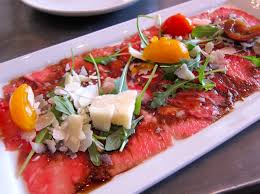In the summer of 2015, some 150 people were stricken with Salmonella at uppity Fig and Olive restaurants in Washington, D.C. and Los Angeles.
When you order truffle risotto at an upscale restaurant—the kind that lists local farms at the top of its menu—you might expect that the dish is prepared fresh, from-scratch in the kitchen. But at Fig & Olive, the $26 truffle risotto (no longer on the menu) was pre-cooked and frozen at a central commissary in Long Island City, New York, then shipped to restaurants around the country, where it was reheated with cheese and garnished.
In fact, the commissary supplies Fig & Olive restaurants with nearly 200 dish components, including soups, sauces, purees, dressings, desserts, breads, ratatouille, ravioli, crab cakes, pre-cooked chicken tagine, pre-cooked paella, and more.
Fig & Olive representatives declined to comment, but a Freedom of Information Act request to the D.C. Department of Health by Washington City Paper reveals new details about how the restaurant sourced and prepared food linked to a salmonella outbreak this fall. Fig & Olive diners from D.C. to California suffered from the potentially fatal bacterial infection, which forced DOH to shut down the new CityCenter, DC restaurant for six days in September.
The D.C. Department of Forensic Sciences tested 84 environmental and food samples from Fig & Olive, but none tested positive for salmonella. That said, DOH Director LaQuandra Nesbitt stated that it’s rare to isolate a particular ingredient in an outbreak. DOH did, however, home in on truffle oil as a common ingredient among many who got sick, and the restaurant removed all dishes with truffle oil from its menu after it reopened.
Fig & Olive’s brand centers around the 30 olive oils (including truffle oil) carrying its name and sold at retail. Emails between Fig & Olive representatives and DOH reveal the restaurant chain’s truffle oil supplier was Veronica Foods, but they have reportedly since switched to International Gourmet Foods.
 In court documents, Fig & Olive denied responsibility for the salmonella outbreak and blamed a third party, although that third party was not named.
In court documents, Fig & Olive denied responsibility for the salmonella outbreak and blamed a third party, although that third party was not named.
In addition to testing samples from the D.C. restaurant, investigators had hoped to collect food samples at Fig & Olive’s New York commissary. Unfortunately, they never got the chance. On Oct. 6, the Centers for Disease Control, leading a multi-state investigation, shared the following update from the U.S. Food and Drug Administration with health officials:
New York District Office initiated an inspection at the Fig and Olive Commissary on 10/1/15 jointly with an investigator from New York State Department of Agriculture & Markets. Currently, no product is available for sampling. The Firm stated they’re currently not in production and haven’t been since “on or about 09/18/2015.” There has been no indication of when production will resume. The Firm does not have any pertinent products on premise. There are no mushrooms readily available for sampling. The firm also serves as a storage facility for a variety of private label “Fig & Olive Retail Collection” olive oils, to which they ship to their 8 locations to be sold.
Even investigators seemed surprised by some recipe shortcuts. In conversations attempting to identify a possible contamination point, a CDC epidemiologist asked a DOH epidemiologist if she know whether Fig & Olive’s truffle olive oil aioli was made with raw or pasteurized eggs. The answer was neither. The DOH epidemiologist noted the chef told her he uses Hellmann’s mayonnaise instead.
“Ha. So I guess even fancy restaurants use name brand mayo for their aioli,” the CDC epidemiologist wrote in an email.
“It was a bit of a surprise!” her DOH counterpart remarked.

